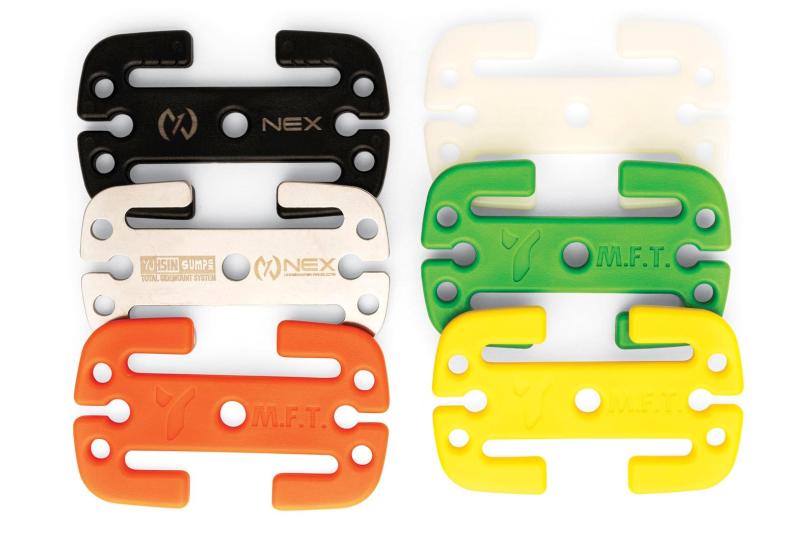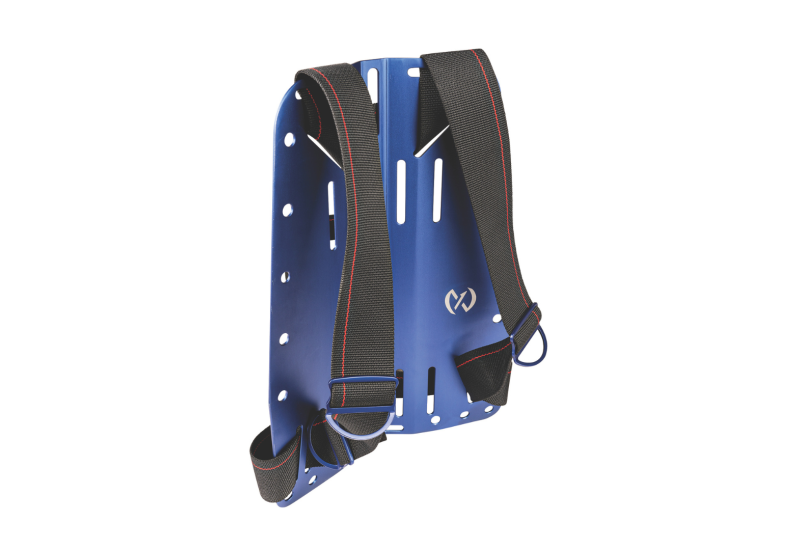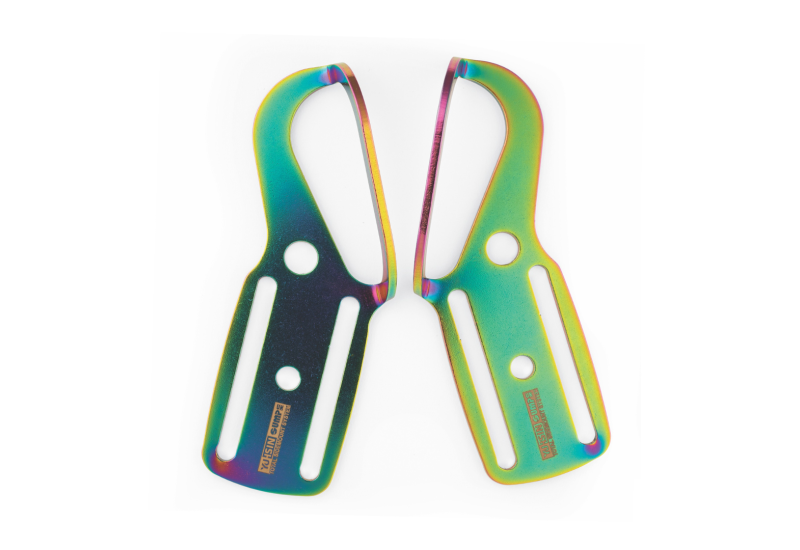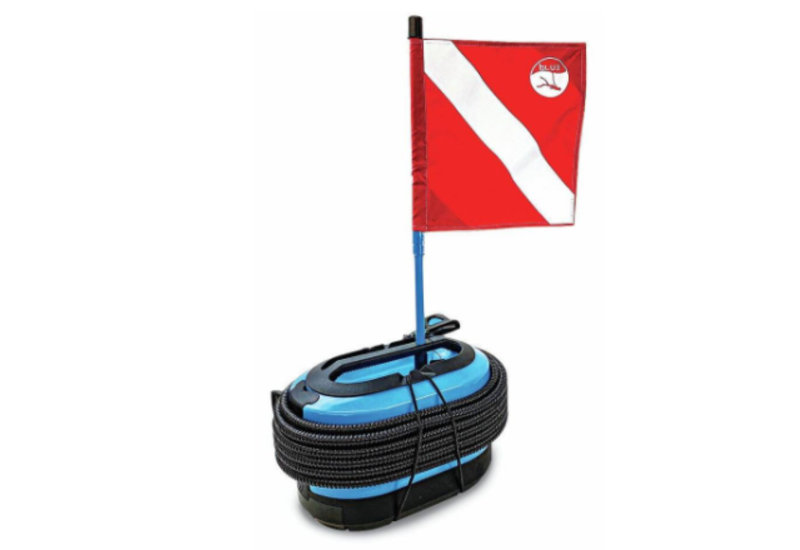12 Weight-Integrated Jacket-Style BCs
January 2002
By John Brumm
BCs Reviewed in This Article
| Aqua Lung Maverick RDS Genesis Phantom IDI Nekton 2000 Mares Vector Platinum with MRS Ocean Reef Tek 840 Oceanic Probe | Parkway Tiburon Riptide Legend Scubapro Classic Plus SeaQuest Pro QD SeaQuest Pro Unlimited Sherwood Avid |
For the first time in history, a majority of divers own a weight-integrated BC, be it jacket-style, back-buoyancy or technical. Why? One major reason is that manufacturers have solved many of the problems of early weight-integrated BCs. And while there will always be inherent disadvantages in tying buoyancy and counter-buoyancy together in one system, the advantages have clearly tipped the scales in their favor.
The 12 weight-integrated jacket-style BCs reviewed here prove this point. Submitted by 11 manufacturers, these are among the best weight-integrated jacket-style BCs available to recreational divers today.
The Testing
Each BC was unpacked and assembled at Scuba Lab. Owner's manuals were reviewed. Everything from D-rings to pockets to padding was scrutinized. BCs were tested for fit and strapped to a tank. All valves and inflators were exercised, integrated weights dry-tested for function. Once all systems were shown to be in proper working condition, the BCs were hauled down to the water.
Over the past nine years, as a result of 16 separate BC evaluations, Scuba Lab has established a test protocol in which specific subjective and objective criteria are applied to BCs in order to extract data based on a testing standard rather than on general impressions. Here's how the test protocol breaks down.
Subjective Evaluations
Assembly - Performed on deck without instructions. Although we believe all BCs should be supplied with clear and complete instructions, we also know that most divers do not take the instructions with them on a dive trip. So the question becomes: Are these intuitive systems or, without owner's manuals, will we become lost in a jungle of straps and buckles?
Fit, comfort and adjustment - Checked both in and out of the water. Adjustment was repeated during underwater tests.
Attitude and stability - Evaluated while swimming under water to determine if the BC would keep the diver in the proper swimming position without wobbling or tending to turn the diver over.
Access to attachments and pockets - Tested in and out of the water. All available methods of securing hoses were also tested.
Valve operation - Evaluated by the ease with which a diver could find and use the oral and power inflators, the oral deflate, the remote exhaust on the shoulder (if applicable) and the rear remote exhaust.
Ascent control - A measurement of how easily the BC could be used to control a normal ascent.
Weight system - Evaluated by the ease of loading and unloading, effect on attitude and stability, and ease of ditching.
Mechanical Evaluations
Flow rate of inflate and deflate valves - Scoring was based on the ability of the deflate valves to flow air faster than the power inflator.
Air trapping - A measurement of how much air was left in a BC's air cell after the deflate valves had been operated in the normal swimming position.
Inherent buoyancy - Measured with the BC empty.
Buoyant lift - The total lift capacity measured with the BC full. This was then compared to the manufacturer's rated lift capacities. Due to variations in how BCs are tested, the fact that BCs require a good deal of hand work to manufacture and that they are made of flexible material, a 10 percent variation between stated and measured lift capacities is considered reasonable, and up to a 20 percent variation is not unusual. But a variation greater than 20 percent means the manufacturer is not providing reasonably useful data to divers shopping for a BC.
Ed's. note: For the purposes of this review, a "hard" backpack is defined as a molded, nonflexible, hard plastic design that supports the tank with the help of a single tank band. A "soft" backpack is defined as a flexible, foldable nonmolded design that usually gets some of its tank support through the use of an additional tank band.
BC Trends
Seems that BC makers are paying attention: state of the art keeps getting better.
-
Black is back. Gone are the days of eye-popping color choices. All test BCs are available in black only, although a few feature subtle color piping.
-
Where's the leak? Past BC tests have revealed leakage problems in inflator valve systems. Of all BCs tested in this group, only one had an initial leak in its system, and that was the result of a not-quite-tight valve cap. Once tightened, the problem disappeared.
-
Where's the inherent buoyancy? Multiple measurements of inherent buoyancy placed all test BCs in the "none to minimal" range, rendering the category inconsequential to these reviews. It was therefore not mentioned in the individual write-ups.
-
Fast dump valves. While execution times varied widely, all exhaust valves expelled air faster than the power inflators were able to put it in. Consequently, if the power inflators on any of these BCs were to stick in the open position, these systems are designed to enable deflation to stay ahead of inflation, avoiding a potential uncontrolled ascent.
Tips For Weight Ditch Systems
-
Get the weight. Though it may not look like it at first, a standard 10-pound lead weight fits easily into these ditchable weight pouches. Most manufacturers recommend soft weights for comfort, but a curved lead weight in a contoured weight pouch works quite efficiently and comfortably.
-
Make it ditchable. Trim weights must not be used as your primary source of ballast. Nonreleasable weight pouches should be loaded only with ballast that supplements the releasable weights.
-
Load up. There's an ongoing debate as to when it's best to load weights into the BC. Loading before you put on the BC can be easier, but you end up hefting a whole lot more weight onto your back--bad news for your dive buddy or boat crew, many of whom simply won't lift a BC loaded with weight anymore. Of course, depending upon what model you're wearing, loading weights after you put your BC on can range from effortless to downright difficult.
-
Empty your bladder. Whether you load your BC on deck or after you climb into it, always make sure to fully deflate the bladder before inserting the pouches. Makes a world of difference.
Velcro vs. Mechanical Closures
Although the vast majority of BCs tested use Velcro closures in their weight-ditch systems, the seven BCs earning Testers' Choice designations are divided equally between those using Velcro--Aqua Lung's Maverick, SeaQuest's Pro QD and Pro Unlimited--and those using mechanical systems--Oceanic's Probe, Scubapro's Classic Plus and Sherwood's Avid. (The Genesis Phantom currently uses Velcro but is switching to Sherwood's mechanical design.) So which is the better system?
Nothing says "security" like the decisive click of a mechanical buckle. But many mechanical systems are not immediately understandable, and some (but not all) require a couple of steps to deploy their weights.
Velcro systems, on the other hand, are usually easy to understand, and they almost always offer single-motion deployment. But Velcro closures, if attached haphazardly, can pull loose, especially if the Velcro is old.
And therein lies the rub. A mechanical buckle doesn't wear out; Velcro does. Even the biggest fans of Velcro systems acknowledge this. So what kind of life span can we expect from a Velcro system? That depends on two factors: the quality of the Velcro (we couldn't discern any difference between the Velcro on the least expensive BC tested and the top-of-the-line model), and how well that Velcro is maintained.
Even the best Velcro won't last long if you don't take care of it. Keeping it out of the sun when not in use is a good start (ultraviolet rays are murder on Velcro). Even more important is keeping the Velcro clean. In Velcro's "hook and loop" system, the hooks commonly get jammed with sand and debris, and the loops get matted. The combination can reduce the sheer strength of any Velcro to a fraction of its potential.
So if you decide on a BC with a Velcro weight system, take time to inspect the Velcro before hitting the water. Make sure the hook side is clean and the loop side is not matted (if it is, fluff it). And always pay attention when loading weights. Divers impatient to get in the water will often haphazardly slap the Velcro flaps together, only to lose their weights halfway down to their favorite reef because the weight pockets weren't adequately secured.
By keeping your Velcro clean and making sure the closures are securely attached, you'll extend the life of your Velcro weight system, allowing you to dive your BC longer, and more safely.
Try It On For Size
The key to buying the right BC is proper fit. Not all BCs are going to be comfortable on you. Make a list of the BCs that offer the features you're looking for, then go to your dive store and try on each while wearing your exposure suit. The right BC must not only be comfortable, it must fit you correctly in the middle of its adjustment range.
Also make sure the BC offers buoyant lift--in your size--suitable to your particular diving style. In general, look for 12 to 24 pounds if you're a tropical diver, 20 to 40 pounds if you're a temperate water diver, and 40 to 80 pounds if you're a technical diver. Don't get more than you need; having too much buoyant lift can be as much of a hindrance to safe, comfortable diving as not having enough.
What's In A Warranty?
The following warranty information is taken directly from BC owner's manuals.
Aqua Lung: Limited two-year warranty. Covers all power inflator parts for two years; lifetime coverage on bladder seams.
Genesis/Sherwood: Limited two-year warranty. Covers all nonwearing valve parts and the welded seams of the air cell for two years.
IDI: Lifetime warranty. Warrants BC to be free from defects in material and workmanship for the lifetime of the original owner, under normal use, proper care and reasonable and necessary maintenance.
Mares: One-year warranty. Warrants BC to be free from defects in materials and workmanship under normal use and service for of one year.
Ocean Reef: Limited two-year warranty. Specifics not available.
Oceanic: Limited two-year warranty. Specifics not available.
Parkway: Limited lifetime warranty. Covers BC for the useful life of the product against defects in materials and workmanship.
Riptide: Lifetime warranty. Warrants against any manufacturing defects, including the inflator, hoses, stitching, zippers, buckles and air cell, for the lifetime of original owner.
Scubapro: Two-year warranty. Warrants against defects in materials and workmanship for two years, except for 1) the Thermoplastic Rubber airway hose, which is covered for one year, and 2) the Finseal bladder seams, which are covered for lifetime of the original owner.
SeaQuest: Limited lifetime. Warrants that the BC will remain free from defects in material and workmanship throughout its useful life.
The Small Print
-
All warranties remain active only if you take your BC in at least once a year for a service and inspection by an authorized dealer.
-
Warranties extend only to the original purchaser; they are not transferable.
-
Warranties do not cover abrasions, punctures or tears to the bladder, or seam separation caused by chemical attack (including prolonged exposure to chlorine).
-
Warranties do not extend to damages caused by improper use, improper maintenance, neglect, unauthorized repairs, modifications, accidents, fire or casualty. Nor do they apply to cosmetic damage, such as scratches and frays.
-
Warranties are limited to repair or replacement at the discretion of the manufacturer.
BCs in Review
Aqua Lung Maverick RDS
||
|---|
|

|
| Aqua Lung Maverick RDS|
Price: $400.Pockets with closures: 2 Velcro.Sizes: 5.Buoyant lift (claimed): 25-45 lbs.Weight system: Ditchable, 20 lbs. max.; nonditchable, 10 lbs. max.Backpack: Hard.Tank bands: 1.
Thumbs Up: Weight loading and ditching. Good ascent control. Efficient valve operation. Stable at depth. Excellent owner's manual.
Thumbs Down: No tank or chest straps. Volume of pockets is affected by integrated weights.
Aqua Lung Maverick RDS: Great BC, Great Price
Marketed as an "entry-level" weight-integrated BC, the Maverick RDS (for Rapid Deployment Weight System) earned perfect scores for its weight system and exceptional scores just about everywhere else, making it a Testers' Choice. It's also one of the least expensive BCs in this test group, which also makes it a Best Buy.
We found that ample shoulder adjustment and a depth-compensating cummerbund ensured a snug fit. The hard backpack and single strap hold the tank securely, contributing to stability at depth. With the Powerline inflator, you can easily fine-tune your buoyancy, although the pull dump valve operates a little stiffly. The deflate system incorporates two remote exhaust valves.
The excellent weight system features curved pouches that contour to body shape. They're held in place by a single Velcro flap, load easily and ditch with a simple tug on the plastic handle. Small buckle clips secure the rear trim weight pouches.
There are some small but noticeable omissions. Positioning the BC on a tank would be even easier if there were a tank valve strap. Padding is a little thin in the spinal area, and there are only three small D-rings and no carrying handle.
Genesis Phantom
||
|---|
|

|
| Genesis Phantom|
Price: $450.Pockets with closures: 2 Velcro.Sizes: 6.Buoyant lift (claimed): 20-40 lbs.Weight system: Ditchable, 16-20 lbs.; nonditchable, 10 lbs. max.Backpack: Hard.Tank bands: 1.
Thumbs Up: Decent access to pockets. Good weight ditch system. Stable at depth. Efficient valve operation. Great accessories and owner's manual.
Thumbs Down: Minimal padding in spinal area. Some body squeeze.
Genesis Phantom: Fit Means Comfort
When it comes to buying a BC, fit is clearly the key. The Genesis Phantom makes this easy with a half-dozen sizes to choose from. Excellent adjustment straps, a quick-release buckle system and a depth-compensating cummerbund add comfort to the equation.
The Phantom's integrated weight system features good-sized plastic pull handles and an additional security flap over the main Velcro closure to help keep weights in place. While not the easiest to load when wearing the BC, weights nonetheless ditch efficiently. Trim weight pouches use buckle clips. The power inflator provides a comfortable grip. Air flow is good; all valves dump efficiently. No tank wobble was detected at depth.
Two stainless-steel D-rings and one half of a buckle clip are standard on the Phantom for attaching accessories. To the delight of the gadget-heads among us, the test BC came equipped with the optional Akona Pro Kit, which includes a dive light on a retractor, a dive knife that mounts over the left pocket, and another retractor for clipping on a compass or dive computer. Very cool stuff. The knife deploys easily, but sheathing it can be nerve-wracking for fear of slicing the BC material. Especially challenging wearing gloves.
{mospagebreak} IDI Nekton 2000
||
|---|
|

|
| IDI Nekton 2000|
Price: $550.Pockets with closures: 3 zippered.Sizes: 4.Buoyant lift (claimed): 30-45 lbs.Weight system: Ditchable, 20 lbs. max.; nonditchable, 10 lbs. max.Backpack: Soft.Tank bands: 2.
Thumbs Up: Good access to pockets and attachments. Efficient air dumping. Lots of padding along the back and lumbar region. Excellent warranty.
Thumbs Down: Power inflator is awkward to grip. Sloppy weight pouches.
IDI Nekton 2000: Useful Complexity
At first glance, the Nekton 2000 appears complex and tricky. But there is method to this mass of straps and buckles, and it's all designed to maximize fit.
Vertical straps run underneath the arms. The Adjustable Torso-Rail system allows for differing torso lengths. The upper tank band adjusts up or down and works with two tank stabilizer bands attached to the shoulder straps; they all pull together to increase tank stability.
This BC is built for carrying additional gear. There are 10 small plastic D-rings and two large zippered pockets that are easily accessible. There's also a small zippered pouch on the cummerbund.
The integrated weight system isn't one of this BC's strong points. Although weight pouches can be loaded while wearing the BC, it's not intuitive. The primary Velcro fastening flap is supported by a secondary Velcro strap that adds security but increases complexity. However, the ditch portion of the system works exceptionally well. At depth, weights can feel a little sloppy in their pouches and have a tendency to ride up on you when inverted, affecting stability.
While slow to inflate (the power inflator is awkward to grip), exhaust flow is outstanding. Manufacturer claims for buoyant lift closely match test rates.
Mares Vector Platinum with MRS
||
|---|
|

|
| Mares Vector Platinum with MRS|
Price: $369 without weight pouches; $399 with weight pouches.Pockets with closures: 2 zippered.Sizes: 5.Buoyant lift (claimed): 23-45 lbs.Weight system: Ditchable, 32 lbs. max.Backpack: Hard.Tank bands: 1.
Thumbs Up: Easy-to-use power inflator for controlled ascents. Two remote exhaust valves.
Thumbs Down: Weight system. Considerable variance between claimed and measured buoyant lift.
Mares Vector Platinum with MRS: Ideal for Engineers
The Mares Vector Platinum earned good marks on ascent control thanks to a well-engineered power inflator, and the two remote exhaust valves dumped air efficiently. A reinforced valve strap helps position the BC on a tank while cinching it down. Six plastic D-rings and two swivel hose clips provide many choices for hanging accessories and securing errant hoses. There are good adjustment straps and sufficient padding in the back and lumbar regions. The ambient inflator hose comes with a whistle and an attached inflator dust cap--a nice touch.
The optional MRS (Mechanical Release System) was one of only a handful of test BCs with non-Velcro weight ditch systems. It was also the least efficient. First off, the MRS required tools for assembly. When ready to use, none of the test divers was able to load the weight pouches while wearing the BC, even with help from dive buddies. In each case, the BC had to be removed from the diver's back and the pockets smoothed flat before weights could be properly loaded.
The problem is that a plastic slider on the weight pouch must make contact with a plastic seat tucked inside the BC's pouch sleeve. You can't see it so you can't take aim, and you can't get your hand inside to guide the slider. It was frustrating for test divers.
When it comes to ditching, while theoretically (or perhaps with practice) this might be accomplished in a single fluid motion, during tests it required three distinct steps: 1) pressing the release button on the plastic handle, 2) pulling the handle away from the inner sleeve wall so it clears the locking nub (no easy feat) and 3) sliding the weight pouch from the sleeve.
Ocean Reef Tek 840
||
|---|
|

|
| Ocean Reef Tek 840|
Price: $428 plus $24 per weight pouch.Pockets with closures: 2 zippered, 2 Velcro.Sizes: 4.Buoyant lift (claimed): 27-45 lbs.Weight system: Ditchable, 22 lbs. max.Backpack: Hard.Tank bands: 1.
Thumbs Up: Easy access to pockets. Efficient valve operation and ascent control. Good stability at depth. Easy-to-load weights.
Thumbs Down: Small weight pouch handles hard to hold onto. Chest/sternum strap positioned too high. Minimal padding.
Ocean Reef Tek 840: More Tech Than Rec
Designed for both recreational and tech diving, the Tek 840 comes with a hard carrying handle molded into a hard backpack that makes it easy to mount the BC on a tank. However, due to the minimal padding along the lumbar and back regions, this backpack can be a bit uncomfortable.
There's lots about the Tek 840 to demonstrate its bent for serious diving. Two remote exhaust valves dump air efficiently. Additional equipment can be attached to four stainless-steel and two plastic D-rings. The main zippered pockets are large and easy to get into. There are also a couple of narrow Velcro pockets designed to hold marker buoys or perhaps a flashlight.
The Tek 840 earned good marks for ascent control due largely to a power inflator that fits nicely in the hand and allows for subtle adjustment. Claimed buoyant lift closely matched measured lift.
It was universally agreed that the chest/sternum strap was positioned uncomfortably high, almost to the neck. And the wide strap over the cummerbund offers only limited adjustment. The single bladder creates some body squeeze.
The pouches on the weight system load easily while wearing the BC. They ditch easily too; however, the small handle on the pouches can be difficult to grip. Velcro pads are sewn on both sides of the pouch, topped with a single Velcro flap to increase security.
Oceanic Probe
||
|---|
|

|
| Oceanic Probe|
Price: $519.95 plus weight pouches at $44.95 per pair.Pockets with closures: 2 Velcro.Sizes: 7.Buoyant lift (claimed): 14-41 lbs.Weight system: Ditchable, 20 lbs. max.; nonditchable, 10 lbs. max.Backpack: Hard.Tank bands: 1.
Thumbs Up: Fit, comfort and adjustment. Multiple sizes. Good stability at depth. Good access to attachments and pockets. Unique weight system. Excellent owner's manual.
Thumbs Down: Minimal lumbar and back padding. Inflation rates on the slow side.
Oceanic Probe: Refined, Yet Rugged
A Testers' Choice, the Probe is a refined, yet rugged jacket-style BC sporting features normally found on Oceanic's tech diving BCs, like the Kevlar-reinforced Bioflex air cell. Four stainless-steel and two plastic D-rings accommodate all kinds of extra gear. It even offers double tank mounting as an option.
The tank cinches securely, and when coupled with the versatile adjustment system, the Probe provides exceptional stability at depth. Pockets are among the easiest to access, and the power inflator enables you to make minor adjustments in buoyancy. Claimed buoyant lift came very close to test results.
The Probe's integrated weight system is an interesting departure from other mechanical systems. It uses a pair of contoured weight pouches that slip into BC sleeves then secure with interlocking plastic tabs, through which a retaining pin is inserted to hold everything together. It took a close reading of the instructions, but it's actually a simple and effective system that combines easy loading with one-step ditching.
One caution: The retaining pin must be inserted correctly into the interlocking tabs; otherwise, you risk the weight pouch falling out on its own. It's easy to do right, but if you're not paying attention, it's just as easy to do wrong.
Parkway Tiburon
||
|---|
|

|
| Parkway Tiburon|
Price: $445.Pockets with closures: 2 Velcro.Sizes: 5.Buoyant lift (claimed): 25-42 lbs.Weight system: Ditchable, 20 lbs. max.; nonditchable, 10 lbs. max.Backpack: Hard.Tank bands: 1.
Thumbs Up: Good valve flow rates and power inflator control. Substantial padding. Weights load easily. Excellent warranty.
Thumbs Down: No chest strap. Small handles on weight pockets.
Parkway Tiburon: Plenty of Padding
Parkway's single-bladder Tiburon produced some pretty good inflate/deflate scores, and its claimed buoyant lift closely matched test measurements. Some tank wobble was apparent at depth, but this could be because Tiburon's sizes seem to be cut on the large side. There's no chest strap, which doesn't help matters, but the depth-compensating cummerbund does a decent job of holding the system together. Substantial padding can be found along the back and lumbar region. There are two large pockets, although they can be difficult to access at depth.
The Tiburon uses a standard Velcro weight pouch system with a single Velcro flap for security. The plastic pull handles are on the small side, making it difficult for divers with big hands to hold onto them. But the pouches themselves are high-visibility lime green. If you have to ditch, or if you accidentally drop one when climbing back onto the boat, they'll be easy to see when it comes time for retrieval. Weight pouches tend to flop around a bit in their sleeves. The nonditchable trim weight pockets are secured with quick-release buckles.
One plastic and two stainless-steel D-rings are provided for attaching extra gear. An optional knife can be strapped onto the left pocket's false flap.
Riptide Legend
||
|---|
|

|
| Riptide Trek|
Price: $599.Pockets with closures: 2 Velcro, 2 zippered.Sizes: 4.Buoyant lift (claimed): 36-48 lbs.Weight system: Ditchable, 20 lbs. max.; nonditchable, 10 lbs. max.Backpack: Soft.Tank bands: 2.
Thumbs Up: Excellent access to pockets. Stable at depth, well-balanced in all attitudes. Excellent warranty.
Thumbs Down: Stiff power inflator controls. No owner's manual.
Riptide Legend: A Stable Ride
The Riptide Legend is a well-balanced BC. The handy "tank wrap," coupled with double tank bands, eliminates tank wobble. There are lots of buckles and adjustment straps along with a removable crotch strap to accommodate varying body shapes. That crotch strap, by the way, can come in handy when descending head-first.
The Legend's two expandable front pockets offered the best access seen in this test go-round. This BC holds the record for stainless-steel D-rings (12) and even offers a spot to hook on a pony bottle.
The Legend incorporates a unique vertical-load weight-ditch design. Stationary pouches sewn into the BC have zippered tops where you load bare weights, and Velcro-flap bottoms with pull handles where weights ditch. It's a simple system, and easy to load when wearing the BC, although the zipper, which seals rear-to-front, is difficult to close. (Note: This zipper is currently being redesigned to seal front-to-rear.)
In a simulated emergency situation, weights ditch efficiently (except in the prone position). But during normal weight removal, such as prior to climbing back on the boat, it's best to remove weights from the top; let bare weights drop out the bottom and you stand a good chance of losing them.
Valve control can be a challenge with the Legend. The power inflator fits awkwardly in the hand; the action is jerky--all or nothing. The pull dump is also a bit stiff.
Scubapro Classic Plus
||
|---|
|

|
| Scubapro Classic Plus|
Price: $677 with balanced power inflator; $831 with Air 2.Pockets with closures: 4 zippered.Sizes: 5.Buoyant lift (claimed): 28-66 lbs.Weight system: Ditchable, 20 lbs.; nonditchable, 10 lbs.Backpack: Hard.Tank bands: 1.
Thumbs Up: Good stability. Good access to attachments and pockets. Most secure weight ditch system. Excellent flow on dump valves. Good owner's manual.
Thumbs Down: Limited adjustment.
Scubapro Classic Plus: An Old Favorite Made New
The Classic Plus is the latest version of Scubapro's single-bag stabilizer jacket, which has been a favorite for more than 20 years. A Testers' Choice, it is the only true "jacket" BC of this test group. There are no vertical adjustments or shoulder quick-releases. So choosing the correct size is more critical with the Classic Plus than with BCs sporting multiple adjustments.
A curved hard pack, coupled with a single strap stainless-steel cinch buckle, steadies the tank and eliminates wobble. The power inflator is a little awkward in the hand, but the two remote exhaust valves dump air efficiently. Claimed buoyant lift falls within reasonable variance. Tests showed minimal body squeeze.
The mechanical weight system incorporates contoured weight pouches with two-inch straps and quick-release buckles. All testers agreed this was by far the most secure of all weight systems.
Foam padding along the back/lumbar region, a soft neoprene neck roll and a wide strap over the depth-compensating cummerbund increase comfort. There's good chest pocket access, but only if you reach cross-body. The lower mesh pockets are very small and won't hold much. The Classic Plus provides six stainless-steel D-rings and includes a signal whistle on the inflator hose.
SeaQuest Pro QD
||
|---|
|

|
| SeaQuest Pro QD|
Price: $450.Pockets with closures: 2 zippered.Sizes: 6.*Buoyant lift (claimed): 30-54 lbs.Weight system: Ditchable, 20 lbs. max; nonditchable, 10 lbs. max.Backpack: Hard.Tank bands: 1.
Thumbs Up: Perfect scores on weight ditch system. Very good valve control and flow rates. Stable at depth. Versatile vertical adjustment swivel system. Excellent warranty. Excellent owner's manual.
Thumbs Down: Access to pockets.
* The Pro QD+, an updated version of the Pro QD, is available in 7 sizes.
SeaQuest Pro QD: Easy Ditching, Great Comfort
Contoured padded shoulders, a well-padded back area, a multiset waistband and an ingenious adjustment/quick-release system utilizing swivel buckles contributed to the good scores in adjustment, comfort and fit, and helped make the Pro QD a Testers' Choice.
Although the Pro QD comes standard with SeaQuest's Powerline inflator, the test BC was equipped with the optional Air Source, which combines the function of an inflator with a second stage regulator. The Air Source is ergonomically designed to fit comfortably in the hand. Its smooth valve operation aids in controlling ascents. The ambient hose's pull dump, along with two remote exhaust valves, produced extremely good air flow rates. Claimed buoyant lift falls within reasonable variance.
An internal expanding gusset system maintains an extremely low drag profile even for large bladders. The BC provides a stable ride at depth with little to no body squeeze. There are six stainless-steel D-rings, handy for divers who like gadgets. But the zippered pockets are very difficult to access, especially when the weight pouches are loaded.
The Pro QD utilizes a standard single- flap Velcro weight pouch system. It loads and ditches easily. The pouches are contoured to match body shape. Two trim weight pouches are tucked in behind the back pad and secured by buckle clips.
SeaQuest Pro Unlimited
||
|---|
|

|
| SeaQuest Pro Unlimited|
Price: $820.Pockets with closures: 3 zippered.Sizes: 5.Buoyant lift (claimed): 30-63 lbs.Weight system: Ditchable, 20-32 lbs.; nonditchable, 10 lbs. max.Backpack: Hard.Tank bands: 1.
Thumbs Up: Excellent fit, comfort and adjustment. Perfect scores on weight system. Good stability. Efficient dump valves. Excellent warranty. Excellent owner's manual.
Thumbs Down: Pocket volume eaten up by weights.
SeaQuest Pro Unlimited: First Among Equals
SeaQuest's flagship Pro Unlimited sports the highest price of all BCs in this group and garnered the best test scores, making it a Testers' Choice and first among equals.
The Pro Unlimited shares the same internal gusset, contoured shoulders, padding, multiset waistband and swivel buckle adjustment system as the Pro QD, but throws in a self-adjusting lumbar support system and a vertically adjustable chest strap to allow for dry suit valves. Volume on the two large zippered pockets gets eaten up when weight pouches are loaded, but the cummerbund pocket is larger and easier to access than most.
Like the Pro QD, the Pro Unlimited utilizes a single-flap Velcro weight system. It loads and ditches efficiently. Weight pouches are contoured to match body shape. Two trim weight pouches are tucked in behind the back pad and secured by buckle clips.
Designed for serious diving, the Pro Unlimited comes with six heavy-duty prebent stainless-steel D-rings. Also included is a dive knife in a sheath over the left pocket and a swivel clip on a retractor. The knife is easy to grab, but it can be a challenge slipping it back into the sheath (if you worry about doing damage to your BC or fingers, the knife can be mounted on the console hose instead).
The pull dump on the ambient hose is a little stiff, but the two remote valves provide efficient deflation. Claimed buoyant lift range falls within reasonable variance.
Sherwood Avid
||
|---|
|

|
| Sherwood Avid|
Price: $475.Pockets with closures: 2 zippered.Sizes: 6.Buoyant lift (claimed): 20-40 lbs.Weight system: Ditchable, 16-26 lbs.; nonditchable, 10 lbs. max.Backpack: Soft.Tank bands: 2.
Thumbs Up: Efficient valve operation. Well-designed power inflator for ascent control. Good scores on assembly, fit, comfort and adjustment. Good to excellent weight system. Excellent owner's manual.
Thumbs Down: Pockets hard to access at depth.
Sherwood Avid: A New Weight System and More
A Testers' Choice, the Sherwood Avid came to these tests with a new mechanical weight ditch system that is standard equipment and a bevy of nifty gadgets that are not.
A newly developed weight pouch security system incorporates two-inch quick-release buckles that connect to the BC. By pulling the plastic weight pouch handles, the male portions of the buckle assemblies contract, disconnect from the BC and release the weight pouches in a smooth one-step motion. Loading the weight pouches while wearing the BC is a stretch--literally: you have to reach back to clip the buckle. But the majority of test divers were able to do it without help from dive buddies.
Various adjustment straps and padding on shoulders, back and lumbar region make the Avid a very comfortable BC. Zippered pockets are large, but difficult to access at depth. There's an additional Velcro pocket designed to hold a foldable snorkel (not included) and six stainless-steel D-rings for attaching gear.
The power inflator fits well in the hand and allows for minute adjustments to fine-tune buoyancy. When it's time to deflate fast, two remote valves along with the pull dump produce efficient flow. Two tank straps provide stability at depth with no apparent tank wobble. Only minimal body squeeze was noted.
The test Avid was equipped with the optional Akona Pro Kit, which includes a dive light on a retractor, a swivel clip on a retractor and a dive knife that mounts to the left pocket.
For the first time in history, a majority of divers own a weight-integrated BC, be it jacket-style, back-buoyancy or technical. Why? One major reason is that manufacturers have solved many of the problems of early weight-integrated BCs. And while there will always be inherent disadvantages in tying buoyancy and counter-buoyancy together in one system, the advantages have clearly tipped the scales in their favor.
The 12 weight-integrated jacket-style BCs reviewed here prove this point. Submitted by 11 manufacturers, these are among the best weight-integrated jacket-style BCs available to recreational divers today.
The Testing
Each BC was unpacked and assembled at Scuba Lab. Owner's manuals were reviewed. Everything from D-rings to pockets to padding was scrutinized. BCs were tested for fit and strapped to a tank. All valves and inflators were exercised, integrated weights dry-tested for function. Once all systems were shown to be in proper working condition, the BCs were hauled down to the water.
Over the past nine years, as a result of 16 separate BC evaluations, Scuba Lab has established a test protocol in which specific subjective and objective criteria are applied to BCs in order to extract data based on a testing standard rather than on general impressions. Here's how the test protocol breaks down.
Subjective Evaluations
Assembly - Performed on deck without instructions. Although we believe all BCs should be supplied with clear and complete instructions, we also know that most divers do not take the instructions with them on a dive trip. So the question becomes: Are these intuitive systems or, without owner's manuals, will we become lost in a jungle of straps and buckles?
Fit, comfort and adjustment - Checked both in and out of the water. Adjustment was repeated during underwater tests.
Attitude and stability - Evaluated while swimming under water to determine if the BC would keep the diver in the proper swimming position without wobbling or tending to turn the diver over.
Access to attachments and pockets - Tested in and out of the water. All available methods of securing hoses were also tested.
Valve operation - Evaluated by the ease with which a diver could find and use the oral and power inflators, the oral deflate, the remote exhaust on the shoulder (if applicable) and the rear remote exhaust.
Ascent control - A measurement of how easily the BC could be used to control a normal ascent.
Weight system - Evaluated by the ease of loading and unloading, effect on attitude and stability, and ease of ditching.
Mechanical Evaluations
Flow rate of inflate and deflate valves - Scoring was based on the ability of the deflate valves to flow air faster than the power inflator.
Air trapping - A measurement of how much air was left in a BC's air cell after the deflate valves had been operated in the normal swimming position.
Inherent buoyancy - Measured with the BC empty.
Buoyant lift - The total lift capacity measured with the BC full. This was then compared to the manufacturer's rated lift capacities. Due to variations in how BCs are tested, the fact that BCs require a good deal of hand work to manufacture and that they are made of flexible material, a 10 percent variation between stated and measured lift capacities is considered reasonable, and up to a 20 percent variation is not unusual. But a variation greater than 20 percent means the manufacturer is not providing reasonably useful data to divers shopping for a BC.
Ed's. note: For the purposes of this review, a "hard" backpack is defined as a molded, nonflexible, hard plastic design that supports the tank with the help of a single tank band. A "soft" backpack is defined as a flexible, foldable nonmolded design that usually gets some of its tank support through the use of an additional tank band.
BC Trends
Seems that BC makers are paying attention: state of the art keeps getting better.
Black is back. Gone are the days of eye-popping color choices. All test BCs are available in black only, although a few feature subtle color piping.
Where's the leak? Past BC tests have revealed leakage problems in inflator valve systems. Of all BCs tested in this group, only one had an initial leak in its system, and that was the result of a not-quite-tight valve cap. Once tightened, the problem disappeared.
Where's the inherent buoyancy? Multiple measurements of inherent buoyancy placed all test BCs in the "none to minimal" range, rendering the category inconsequential to these reviews. It was therefore not mentioned in the individual write-ups.
Fast dump valves. While execution times varied widely, all exhaust valves expelled air faster than the power inflators were able to put it in. Consequently, if the power inflators on any of these BCs were to stick in the open position, these systems are designed to enable deflation to stay ahead of inflation, avoiding a potential uncontrolled ascent.
Tips For Weight Ditch Systems
Get the weight. Though it may not look like it at first, a standard 10-pound lead weight fits easily into these ditchable weight pouches. Most manufacturers recommend soft weights for comfort, but a curved lead weight in a contoured weight pouch works quite efficiently and comfortably.
Make it ditchable. Trim weights must not be used as your primary source of ballast. Nonreleasable weight pouches should be loaded only with ballast that supplements the releasable weights.
Load up. There's an ongoing debate as to when it's best to load weights into the BC. Loading before you put on the BC can be easier, but you end up hefting a whole lot more weight onto your back--bad news for your dive buddy or boat crew, many of whom simply won't lift a BC loaded with weight anymore. Of course, depending upon what model you're wearing, loading weights after you put your BC on can range from effortless to downright difficult.
Empty your bladder. Whether you load your BC on deck or after you climb into it, always make sure to fully deflate the bladder before inserting the pouches. Makes a world of difference.
Velcro vs. Mechanical Closures
Although the vast majority of BCs tested use Velcro closures in their weight-ditch systems, the seven BCs earning Testers' Choice designations are divided equally between those using Velcro--Aqua Lung's Maverick, SeaQuest's Pro QD and Pro Unlimited--and those using mechanical systems--Oceanic's Probe, Scubapro's Classic Plus and Sherwood's Avid. (The Genesis Phantom currently uses Velcro but is switching to Sherwood's mechanical design.) So which is the better system?
Nothing says "security" like the decisive click of a mechanical buckle. But many mechanical systems are not immediately understandable, and some (but not all) require a couple of steps to deploy their weights.
Velcro systems, on the other hand, are usually easy to understand, and they almost always offer single-motion deployment. But Velcro closures, if attached haphazardly, can pull loose, especially if the Velcro is old.
And therein lies the rub. A mechanical buckle doesn't wear out; Velcro does. Even the biggest fans of Velcro systems acknowledge this. So what kind of life span can we expect from a Velcro system? That depends on two factors: the quality of the Velcro (we couldn't discern any difference between the Velcro on the least expensive BC tested and the top-of-the-line model), and how well that Velcro is maintained.
Even the best Velcro won't last long if you don't take care of it. Keeping it out of the sun when not in use is a good start (ultraviolet rays are murder on Velcro). Even more important is keeping the Velcro clean. In Velcro's "hook and loop" system, the hooks commonly get jammed with sand and debris, and the loops get matted. The combination can reduce the sheer strength of any Velcro to a fraction of its potential.
So if you decide on a BC with a Velcro weight system, take time to inspect the Velcro before hitting the water. Make sure the hook side is clean and the loop side is not matted (if it is, fluff it). And always pay attention when loading weights. Divers impatient to get in the water will often haphazardly slap the Velcro flaps together, only to lose their weights halfway down to their favorite reef because the weight pockets weren't adequately secured.
By keeping your Velcro clean and making sure the closures are securely attached, you'll extend the life of your Velcro weight system, allowing you to dive your BC longer, and more safely.
Try It On For Size
The key to buying the right BC is proper fit. Not all BCs are going to be comfortable on you. Make a list of the BCs that offer the features you're looking for, then go to your dive store and try on each while wearing your exposure suit. The right BC must not only be comfortable, it must fit you correctly in the middle of its adjustment range.
Also make sure the BC offers buoyant lift--in your size--suitable to your particular diving style. In general, look for 12 to 24 pounds if you're a tropical diver, 20 to 40 pounds if you're a temperate water diver, and 40 to 80 pounds if you're a technical diver. Don't get more than you need; having too much buoyant lift can be as much of a hindrance to safe, comfortable diving as not having enough.
What's In A Warranty?
The following warranty information is taken directly from BC owner's manuals.
Aqua Lung: Limited two-year warranty. Covers all power inflator parts for two years; lifetime coverage on bladder seams.
Genesis/Sherwood: Limited two-year warranty. Covers all nonwearing valve parts and the welded seams of the air cell for two years.
IDI: Lifetime warranty. Warrants BC to be free from defects in material and workmanship for the lifetime of the original owner, under normal use, proper care and reasonable and necessary maintenance.
Mares: One-year warranty. Warrants BC to be free from defects in materials and workmanship under normal use and service for of one year.
Ocean Reef: Limited two-year warranty. Specifics not available.
Oceanic: Limited two-year warranty. Specifics not available.
Parkway: Limited lifetime warranty. Covers BC for the useful life of the product against defects in materials and workmanship.
Riptide: Lifetime warranty. Warrants against any manufacturing defects, including the inflator, hoses, stitching, zippers, buckles and air cell, for the lifetime of original owner.
Scubapro: Two-year warranty. Warrants against defects in materials and workmanship for two years, except for 1) the Thermoplastic Rubber airway hose, which is covered for one year, and 2) the Finseal bladder seams, which are covered for lifetime of the original owner.
SeaQuest: Limited lifetime. Warrants that the BC will remain free from defects in material and workmanship throughout its useful life.
The Small Print
All warranties remain active only if you take your BC in at least once a year for a service and inspection by an authorized dealer.
Warranties extend only to the original purchaser; they are not transferable.
Warranties do not cover abrasions, punctures or tears to the bladder, or seam separation caused by chemical attack (including prolonged exposure to chlorine).
Warranties do not extend to damages caused by improper use, improper maintenance, neglect, unauthorized repairs, modifications, accidents, fire or casualty. Nor do they apply to cosmetic damage, such as scratches and frays.
Warranties are limited to repair or replacement at the discretion of the manufacturer.
BCs in Review
Aqua Lung Maverick RDS
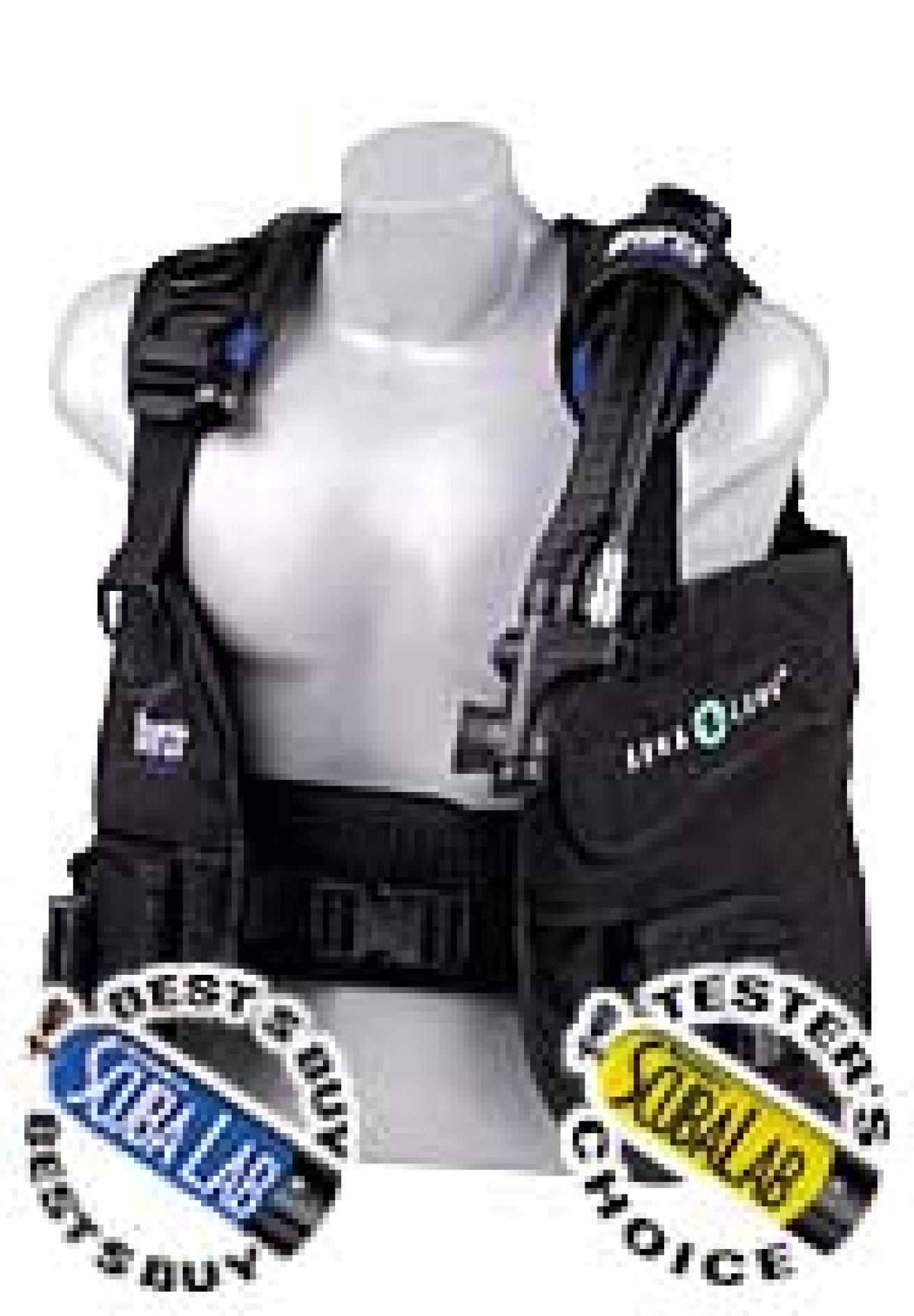
Aqua Lung Maverick RDS|
Price: $400.
Pockets with closures: 2 Velcro.
Sizes: 5.
Buoyant lift (claimed): 25-45 lbs.
Weight system: Ditchable, 20 lbs. max.; nonditchable, 10 lbs. max.
Backpack: Hard.
Tank bands: 1.
Thumbs Up: Weight loading and ditching. Good ascent control. Efficient valve operation. Stable at depth. Excellent owner's manual.
Thumbs Down: No tank or chest straps. Volume of pockets is affected by integrated weights.
Aqua Lung Maverick RDS: Great BC, Great Price
Marketed as an "entry-level" weight-integrated BC, the Maverick RDS (for Rapid Deployment Weight System) earned perfect scores for its weight system and exceptional scores just about everywhere else, making it a Testers' Choice. It's also one of the least expensive BCs in this test group, which also makes it a Best Buy.
We found that ample shoulder adjustment and a depth-compensating cummerbund ensured a snug fit. The hard backpack and single strap hold the tank securely, contributing to stability at depth. With the Powerline inflator, you can easily fine-tune your buoyancy, although the pull dump valve operates a little stiffly. The deflate system incorporates two remote exhaust valves.
The excellent weight system features curved pouches that contour to body shape. They're held in place by a single Velcro flap, load easily and ditch with a simple tug on the plastic handle. Small buckle clips secure the rear trim weight pouches.
There are some small but noticeable omissions. Positioning the BC on a tank would be even easier if there were a tank valve strap. Padding is a little thin in the spinal area, and there are only three small D-rings and no carrying handle.
Genesis Phantom
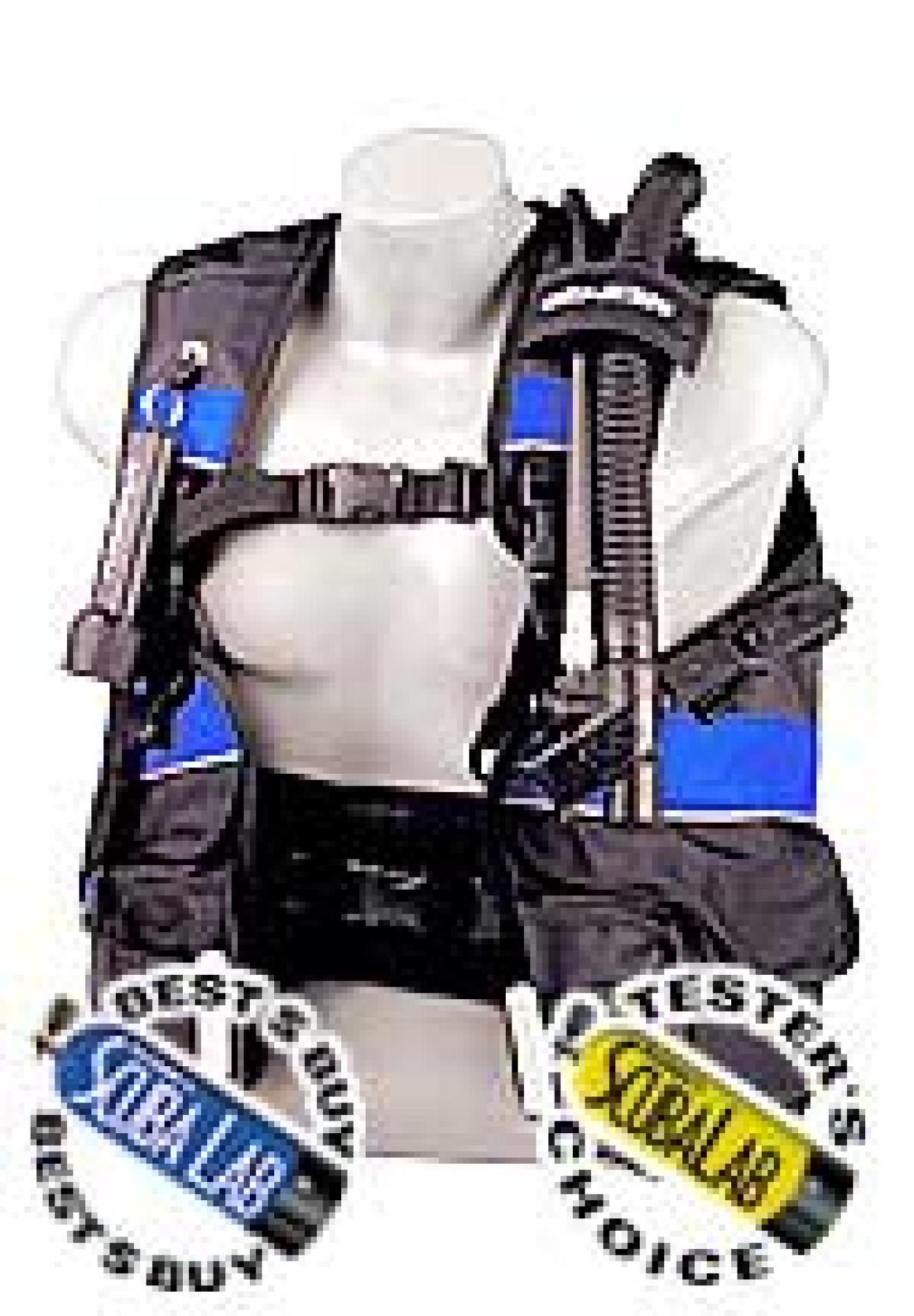
Genesis Phantom|
Price: $450.
Pockets with closures: 2 Velcro.
Sizes: 6.
Buoyant lift (claimed): 20-40 lbs.
Weight system: Ditchable, 16-20 lbs.; nonditchable, 10 lbs. max.
Backpack: Hard.
Tank bands: 1.
Thumbs Up: Decent access to pockets. Good weight ditch system. Stable at depth. Efficient valve operation. Great accessories and owner's manual.
Thumbs Down: Minimal padding in spinal area. Some body squeeze.
Genesis Phantom: Fit Means Comfort
When it comes to buying a BC, fit is clearly the key. The Genesis Phantom makes this easy with a half-dozen sizes to choose from. Excellent adjustment straps, a quick-release buckle system and a depth-compensating cummerbund add comfort to the equation.
The Phantom's integrated weight system features good-sized plastic pull handles and an additional security flap over the main Velcro closure to help keep weights in place. While not the easiest to load when wearing the BC, weights nonetheless ditch efficiently. Trim weight pouches use buckle clips. The power inflator provides a comfortable grip. Air flow is good; all valves dump efficiently. No tank wobble was detected at depth.
Two stainless-steel D-rings and one half of a buckle clip are standard on the Phantom for attaching accessories. To the delight of the gadget-heads among us, the test BC came equipped with the optional Akona Pro Kit, which includes a dive light on a retractor, a dive knife that mounts over the left pocket, and another retractor for clipping on a compass or dive computer. Very cool stuff. The knife deploys easily, but sheathing it can be nerve-wracking for fear of slicing the BC material. Especially challenging wearing gloves.
{mospagebreak} IDI Nekton 2000
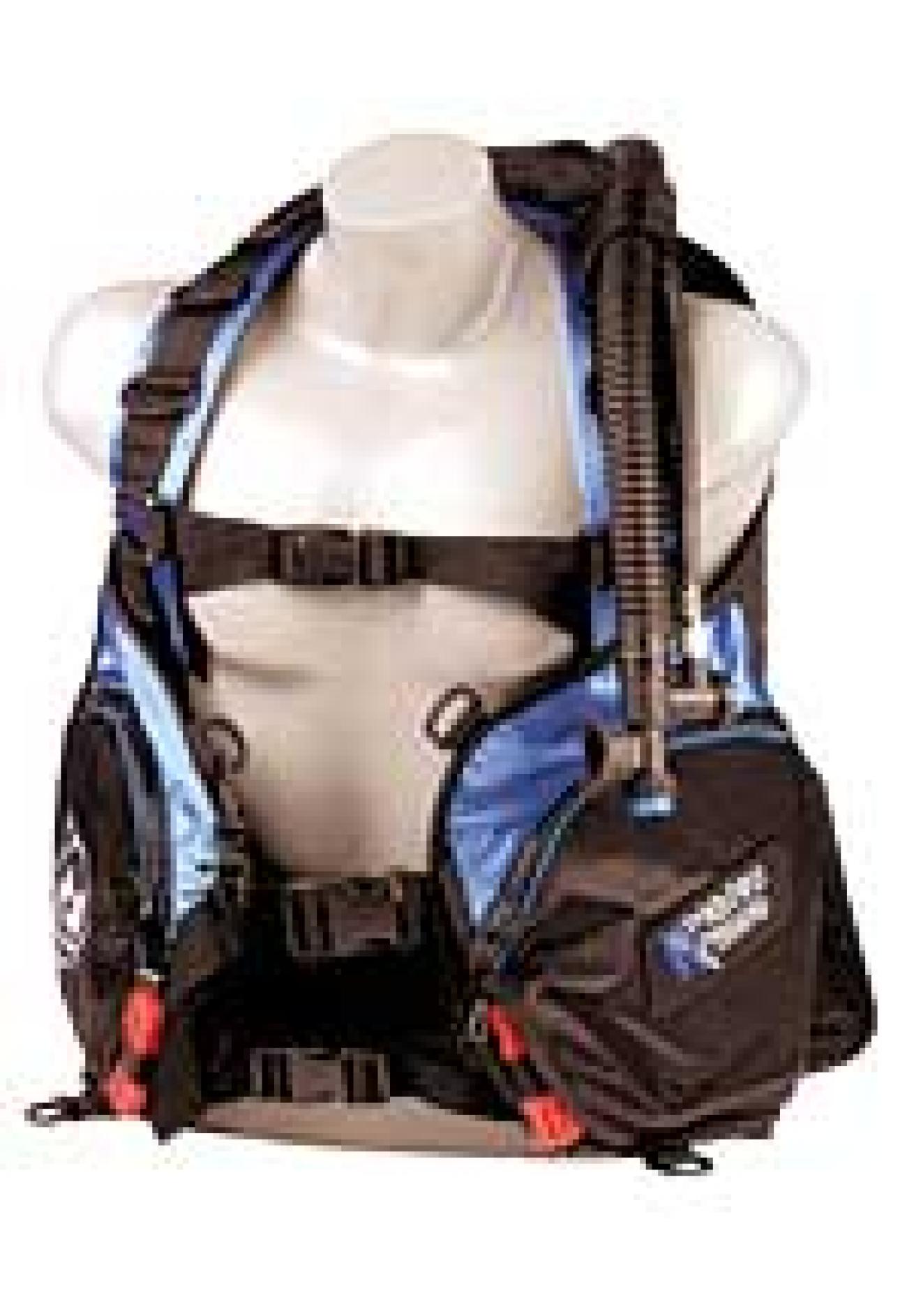
IDI Nekton 2000|
Price: $550.
Pockets with closures: 3 zippered.
Sizes: 4.
Buoyant lift (claimed): 30-45 lbs.
Weight system: Ditchable, 20 lbs. max.; nonditchable, 10 lbs. max.
Backpack: Soft.
Tank bands: 2.
Thumbs Up: Good access to pockets and attachments. Efficient air dumping. Lots of padding along the back and lumbar region. Excellent warranty.
Thumbs Down: Power inflator is awkward to grip. Sloppy weight pouches.
IDI Nekton 2000: Useful Complexity
At first glance, the Nekton 2000 appears complex and tricky. But there is method to this mass of straps and buckles, and it's all designed to maximize fit.
Vertical straps run underneath the arms. The Adjustable Torso-Rail system allows for differing torso lengths. The upper tank band adjusts up or down and works with two tank stabilizer bands attached to the shoulder straps; they all pull together to increase tank stability.
This BC is built for carrying additional gear. There are 10 small plastic D-rings and two large zippered pockets that are easily accessible. There's also a small zippered pouch on the cummerbund.
The integrated weight system isn't one of this BC's strong points. Although weight pouches can be loaded while wearing the BC, it's not intuitive. The primary Velcro fastening flap is supported by a secondary Velcro strap that adds security but increases complexity. However, the ditch portion of the system works exceptionally well. At depth, weights can feel a little sloppy in their pouches and have a tendency to ride up on you when inverted, affecting stability.
While slow to inflate (the power inflator is awkward to grip), exhaust flow is outstanding. Manufacturer claims for buoyant lift closely match test rates.
Mares Vector Platinum with MRS
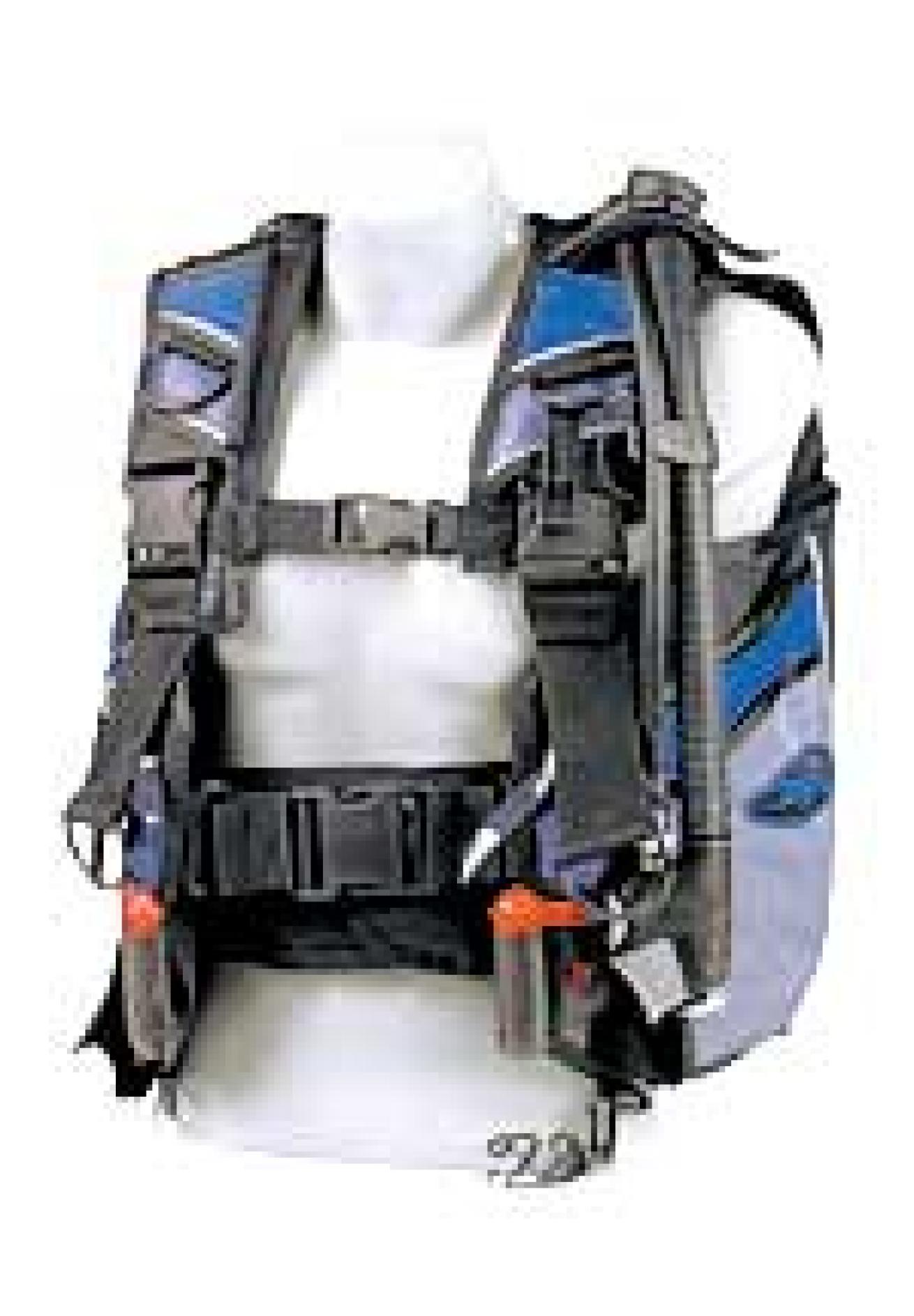
Mares Vector Platinum with MRS|
Price: $369 without weight pouches; $399 with weight pouches.
Pockets with closures: 2 zippered.
Sizes: 5.
Buoyant lift (claimed): 23-45 lbs.
Weight system: Ditchable, 32 lbs. max.
Backpack: Hard.
Tank bands: 1.
Thumbs Up: Easy-to-use power inflator for controlled ascents. Two remote exhaust valves.
Thumbs Down: Weight system. Considerable variance between claimed and measured buoyant lift.
Mares Vector Platinum with MRS: Ideal for Engineers
The Mares Vector Platinum earned good marks on ascent control thanks to a well-engineered power inflator, and the two remote exhaust valves dumped air efficiently. A reinforced valve strap helps position the BC on a tank while cinching it down. Six plastic D-rings and two swivel hose clips provide many choices for hanging accessories and securing errant hoses. There are good adjustment straps and sufficient padding in the back and lumbar regions. The ambient inflator hose comes with a whistle and an attached inflator dust cap--a nice touch.
The optional MRS (Mechanical Release System) was one of only a handful of test BCs with non-Velcro weight ditch systems. It was also the least efficient. First off, the MRS required tools for assembly. When ready to use, none of the test divers was able to load the weight pouches while wearing the BC, even with help from dive buddies. In each case, the BC had to be removed from the diver's back and the pockets smoothed flat before weights could be properly loaded.
The problem is that a plastic slider on the weight pouch must make contact with a plastic seat tucked inside the BC's pouch sleeve. You can't see it so you can't take aim, and you can't get your hand inside to guide the slider. It was frustrating for test divers.
When it comes to ditching, while theoretically (or perhaps with practice) this might be accomplished in a single fluid motion, during tests it required three distinct steps: 1) pressing the release button on the plastic handle, 2) pulling the handle away from the inner sleeve wall so it clears the locking nub (no easy feat) and 3) sliding the weight pouch from the sleeve.
Ocean Reef Tek 840
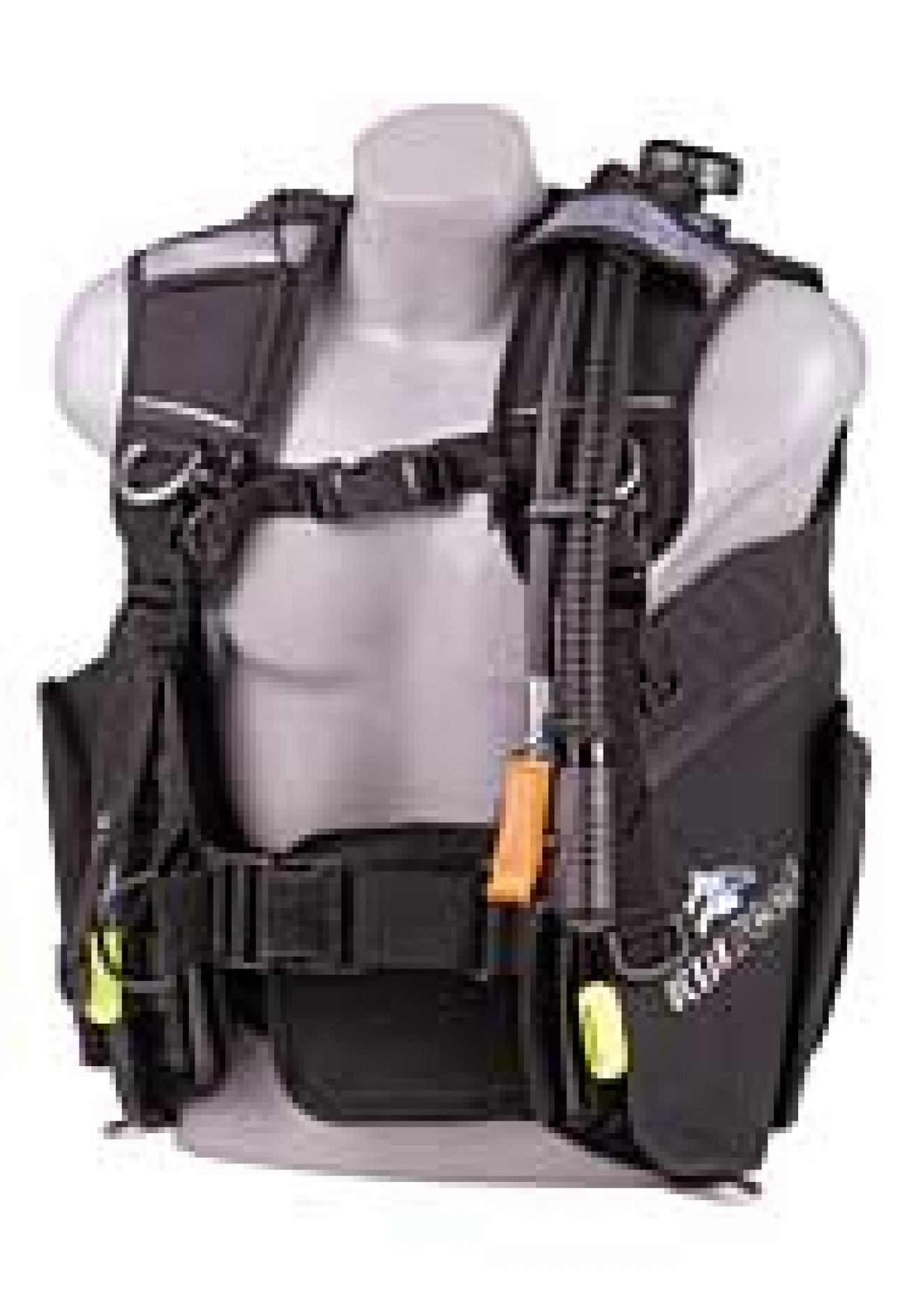
Ocean Reef Tek 840|
Price: $428 plus $24 per weight pouch.
Pockets with closures: 2 zippered, 2 Velcro.
Sizes: 4.
Buoyant lift (claimed): 27-45 lbs.
Weight system: Ditchable, 22 lbs. max.
Backpack: Hard.
Tank bands: 1.
Thumbs Up: Easy access to pockets. Efficient valve operation and ascent control. Good stability at depth. Easy-to-load weights.
Thumbs Down: Small weight pouch handles hard to hold onto. Chest/sternum strap positioned too high. Minimal padding.
Ocean Reef Tek 840: More Tech Than Rec
Designed for both recreational and tech diving, the Tek 840 comes with a hard carrying handle molded into a hard backpack that makes it easy to mount the BC on a tank. However, due to the minimal padding along the lumbar and back regions, this backpack can be a bit uncomfortable.
There's lots about the Tek 840 to demonstrate its bent for serious diving. Two remote exhaust valves dump air efficiently. Additional equipment can be attached to four stainless-steel and two plastic D-rings. The main zippered pockets are large and easy to get into. There are also a couple of narrow Velcro pockets designed to hold marker buoys or perhaps a flashlight.
The Tek 840 earned good marks for ascent control due largely to a power inflator that fits nicely in the hand and allows for subtle adjustment. Claimed buoyant lift closely matched measured lift.
It was universally agreed that the chest/sternum strap was positioned uncomfortably high, almost to the neck. And the wide strap over the cummerbund offers only limited adjustment. The single bladder creates some body squeeze.
The pouches on the weight system load easily while wearing the BC. They ditch easily too; however, the small handle on the pouches can be difficult to grip. Velcro pads are sewn on both sides of the pouch, topped with a single Velcro flap to increase security.
Oceanic Probe

Oceanic Probe|
Price: $519.95 plus weight pouches at $44.95 per pair.
Pockets with closures: 2 Velcro.
Sizes: 7.
Buoyant lift (claimed): 14-41 lbs.
Weight system: Ditchable, 20 lbs. max.; nonditchable, 10 lbs. max.
Backpack: Hard.
Tank bands: 1.
Thumbs Up: Fit, comfort and adjustment. Multiple sizes. Good stability at depth. Good access to attachments and pockets. Unique weight system. Excellent owner's manual.
Thumbs Down: Minimal lumbar and back padding. Inflation rates on the slow side.
Oceanic Probe: Refined, Yet Rugged
A Testers' Choice, the Probe is a refined, yet rugged jacket-style BC sporting features normally found on Oceanic's tech diving BCs, like the Kevlar-reinforced Bioflex air cell. Four stainless-steel and two plastic D-rings accommodate all kinds of extra gear. It even offers double tank mounting as an option.
The tank cinches securely, and when coupled with the versatile adjustment system, the Probe provides exceptional stability at depth. Pockets are among the easiest to access, and the power inflator enables you to make minor adjustments in buoyancy. Claimed buoyant lift came very close to test results.
The Probe's integrated weight system is an interesting departure from other mechanical systems. It uses a pair of contoured weight pouches that slip into BC sleeves then secure with interlocking plastic tabs, through which a retaining pin is inserted to hold everything together. It took a close reading of the instructions, but it's actually a simple and effective system that combines easy loading with one-step ditching.
One caution: The retaining pin must be inserted correctly into the interlocking tabs; otherwise, you risk the weight pouch falling out on its own. It's easy to do right, but if you're not paying attention, it's just as easy to do wrong.
Parkway Tiburon
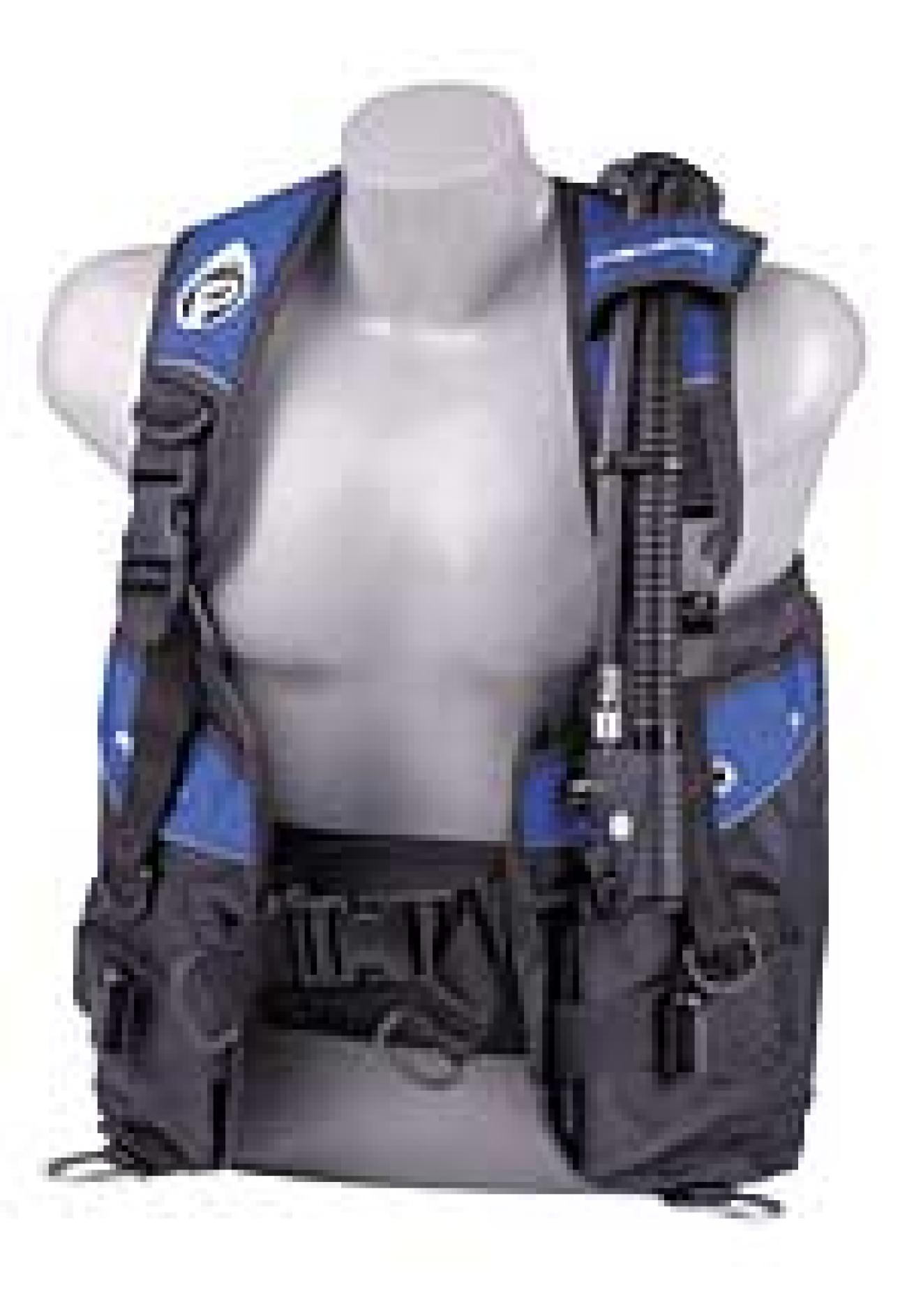
Parkway Tiburon|
Price: $445.
Pockets with closures: 2 Velcro.
Sizes: 5.
Buoyant lift (claimed): 25-42 lbs.
Weight system: Ditchable, 20 lbs. max.; nonditchable, 10 lbs. max.
Backpack: Hard.
Tank bands: 1.
Thumbs Up: Good valve flow rates and power inflator control. Substantial padding. Weights load easily. Excellent warranty.
Thumbs Down: No chest strap. Small handles on weight pockets.
Parkway Tiburon: Plenty of Padding
Parkway's single-bladder Tiburon produced some pretty good inflate/deflate scores, and its claimed buoyant lift closely matched test measurements. Some tank wobble was apparent at depth, but this could be because Tiburon's sizes seem to be cut on the large side. There's no chest strap, which doesn't help matters, but the depth-compensating cummerbund does a decent job of holding the system together. Substantial padding can be found along the back and lumbar region. There are two large pockets, although they can be difficult to access at depth.
The Tiburon uses a standard Velcro weight pouch system with a single Velcro flap for security. The plastic pull handles are on the small side, making it difficult for divers with big hands to hold onto them. But the pouches themselves are high-visibility lime green. If you have to ditch, or if you accidentally drop one when climbing back onto the boat, they'll be easy to see when it comes time for retrieval. Weight pouches tend to flop around a bit in their sleeves. The nonditchable trim weight pockets are secured with quick-release buckles.
One plastic and two stainless-steel D-rings are provided for attaching extra gear. An optional knife can be strapped onto the left pocket's false flap.
Riptide Legend
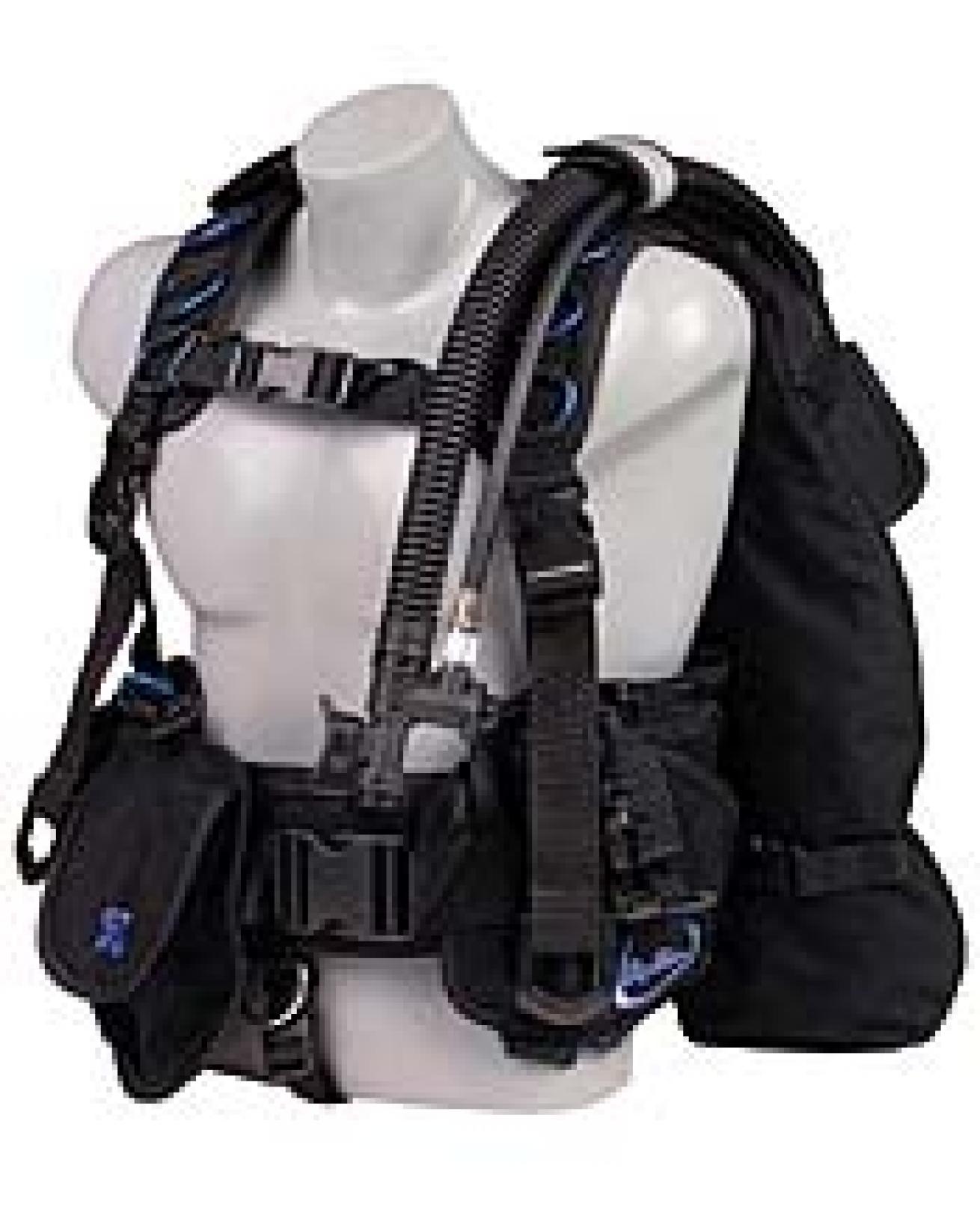
Riptide Trek|
Price: $599.
Pockets with closures: 2 Velcro, 2 zippered.
Sizes: 4.
Buoyant lift (claimed): 36-48 lbs.
Weight system: Ditchable, 20 lbs. max.; nonditchable, 10 lbs. max.
Backpack: Soft.
Tank bands: 2.
Thumbs Up: Excellent access to pockets. Stable at depth, well-balanced in all attitudes. Excellent warranty.
Thumbs Down: Stiff power inflator controls. No owner's manual.
Riptide Legend: A Stable Ride
The Riptide Legend is a well-balanced BC. The handy "tank wrap," coupled with double tank bands, eliminates tank wobble. There are lots of buckles and adjustment straps along with a removable crotch strap to accommodate varying body shapes. That crotch strap, by the way, can come in handy when descending head-first.
The Legend's two expandable front pockets offered the best access seen in this test go-round. This BC holds the record for stainless-steel D-rings (12) and even offers a spot to hook on a pony bottle.
The Legend incorporates a unique vertical-load weight-ditch design. Stationary pouches sewn into the BC have zippered tops where you load bare weights, and Velcro-flap bottoms with pull handles where weights ditch. It's a simple system, and easy to load when wearing the BC, although the zipper, which seals rear-to-front, is difficult to close. (Note: This zipper is currently being redesigned to seal front-to-rear.)
In a simulated emergency situation, weights ditch efficiently (except in the prone position). But during normal weight removal, such as prior to climbing back on the boat, it's best to remove weights from the top; let bare weights drop out the bottom and you stand a good chance of losing them.
Valve control can be a challenge with the Legend. The power inflator fits awkwardly in the hand; the action is jerky--all or nothing. The pull dump is also a bit stiff.
Scubapro Classic Plus

Scubapro Classic Plus|
Price: $677 with balanced power inflator; $831 with Air 2.
Pockets with closures: 4 zippered.
Sizes: 5.
Buoyant lift (claimed): 28-66 lbs.
Weight system: Ditchable, 20 lbs.; nonditchable, 10 lbs.
Backpack: Hard.
Tank bands: 1.
Thumbs Up: Good stability. Good access to attachments and pockets. Most secure weight ditch system. Excellent flow on dump valves. Good owner's manual.
Thumbs Down: Limited adjustment.
Scubapro Classic Plus: An Old Favorite Made New
The Classic Plus is the latest version of Scubapro's single-bag stabilizer jacket, which has been a favorite for more than 20 years. A Testers' Choice, it is the only true "jacket" BC of this test group. There are no vertical adjustments or shoulder quick-releases. So choosing the correct size is more critical with the Classic Plus than with BCs sporting multiple adjustments.
A curved hard pack, coupled with a single strap stainless-steel cinch buckle, steadies the tank and eliminates wobble. The power inflator is a little awkward in the hand, but the two remote exhaust valves dump air efficiently. Claimed buoyant lift falls within reasonable variance. Tests showed minimal body squeeze.
The mechanical weight system incorporates contoured weight pouches with two-inch straps and quick-release buckles. All testers agreed this was by far the most secure of all weight systems.
Foam padding along the back/lumbar region, a soft neoprene neck roll and a wide strap over the depth-compensating cummerbund increase comfort. There's good chest pocket access, but only if you reach cross-body. The lower mesh pockets are very small and won't hold much. The Classic Plus provides six stainless-steel D-rings and includes a signal whistle on the inflator hose.
SeaQuest Pro QD
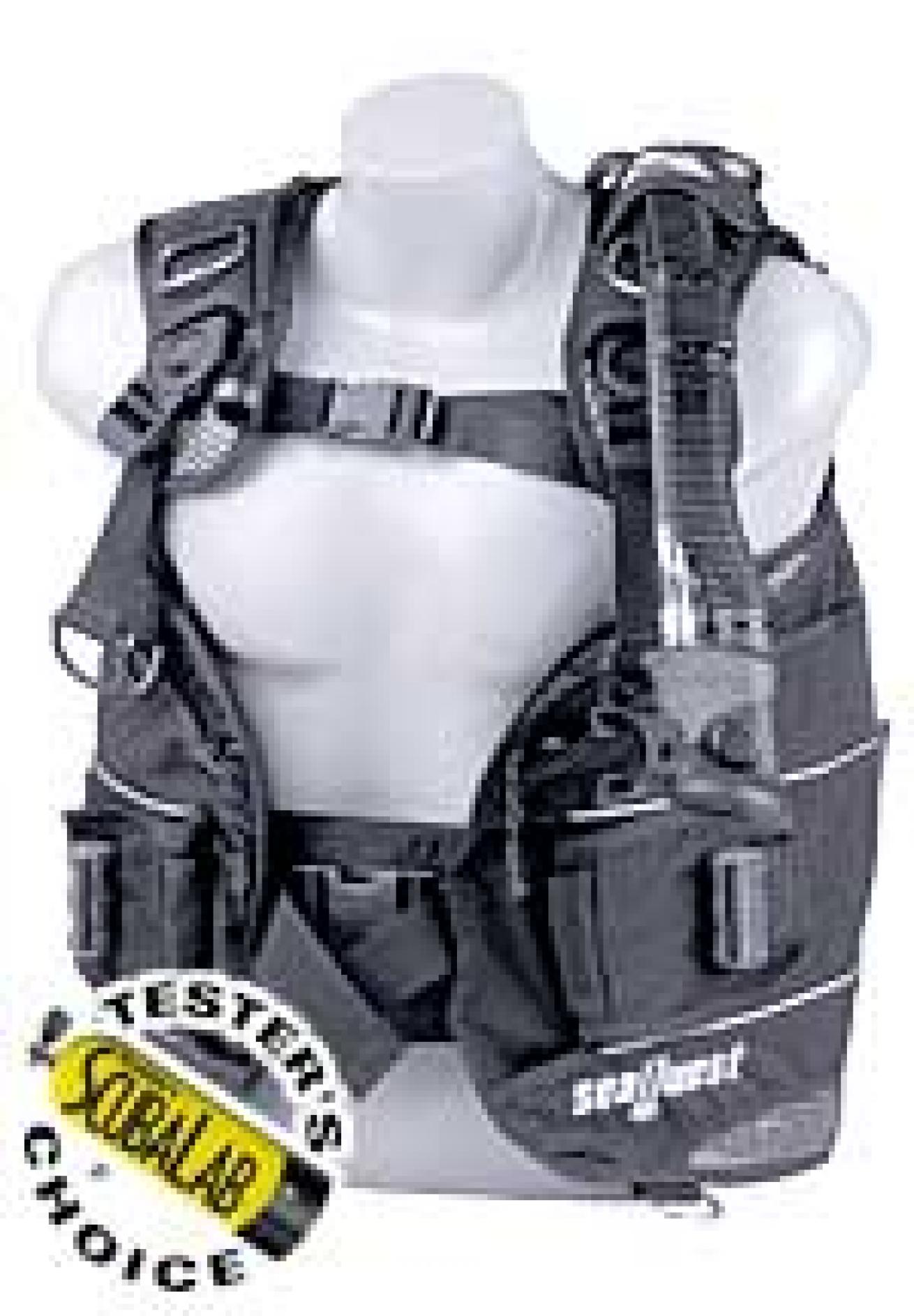
SeaQuest Pro QD|
Price: $450.
Pockets with closures: 2 zippered.
Sizes: 6.*
Buoyant lift (claimed): 30-54 lbs.
Weight system: Ditchable, 20 lbs. max; nonditchable, 10 lbs. max.
Backpack: Hard.
Tank bands: 1.
Thumbs Up: Perfect scores on weight ditch system. Very good valve control and flow rates. Stable at depth. Versatile vertical adjustment swivel system. Excellent warranty. Excellent owner's manual.
Thumbs Down: Access to pockets.
* The Pro QD+, an updated version of the Pro QD, is available in 7 sizes.
SeaQuest Pro QD: Easy Ditching, Great Comfort
Contoured padded shoulders, a well-padded back area, a multiset waistband and an ingenious adjustment/quick-release system utilizing swivel buckles contributed to the good scores in adjustment, comfort and fit, and helped make the Pro QD a Testers' Choice.
Although the Pro QD comes standard with SeaQuest's Powerline inflator, the test BC was equipped with the optional Air Source, which combines the function of an inflator with a second stage regulator. The Air Source is ergonomically designed to fit comfortably in the hand. Its smooth valve operation aids in controlling ascents. The ambient hose's pull dump, along with two remote exhaust valves, produced extremely good air flow rates. Claimed buoyant lift falls within reasonable variance.
An internal expanding gusset system maintains an extremely low drag profile even for large bladders. The BC provides a stable ride at depth with little to no body squeeze. There are six stainless-steel D-rings, handy for divers who like gadgets. But the zippered pockets are very difficult to access, especially when the weight pouches are loaded.
The Pro QD utilizes a standard single- flap Velcro weight pouch system. It loads and ditches easily. The pouches are contoured to match body shape. Two trim weight pouches are tucked in behind the back pad and secured by buckle clips.
SeaQuest Pro Unlimited
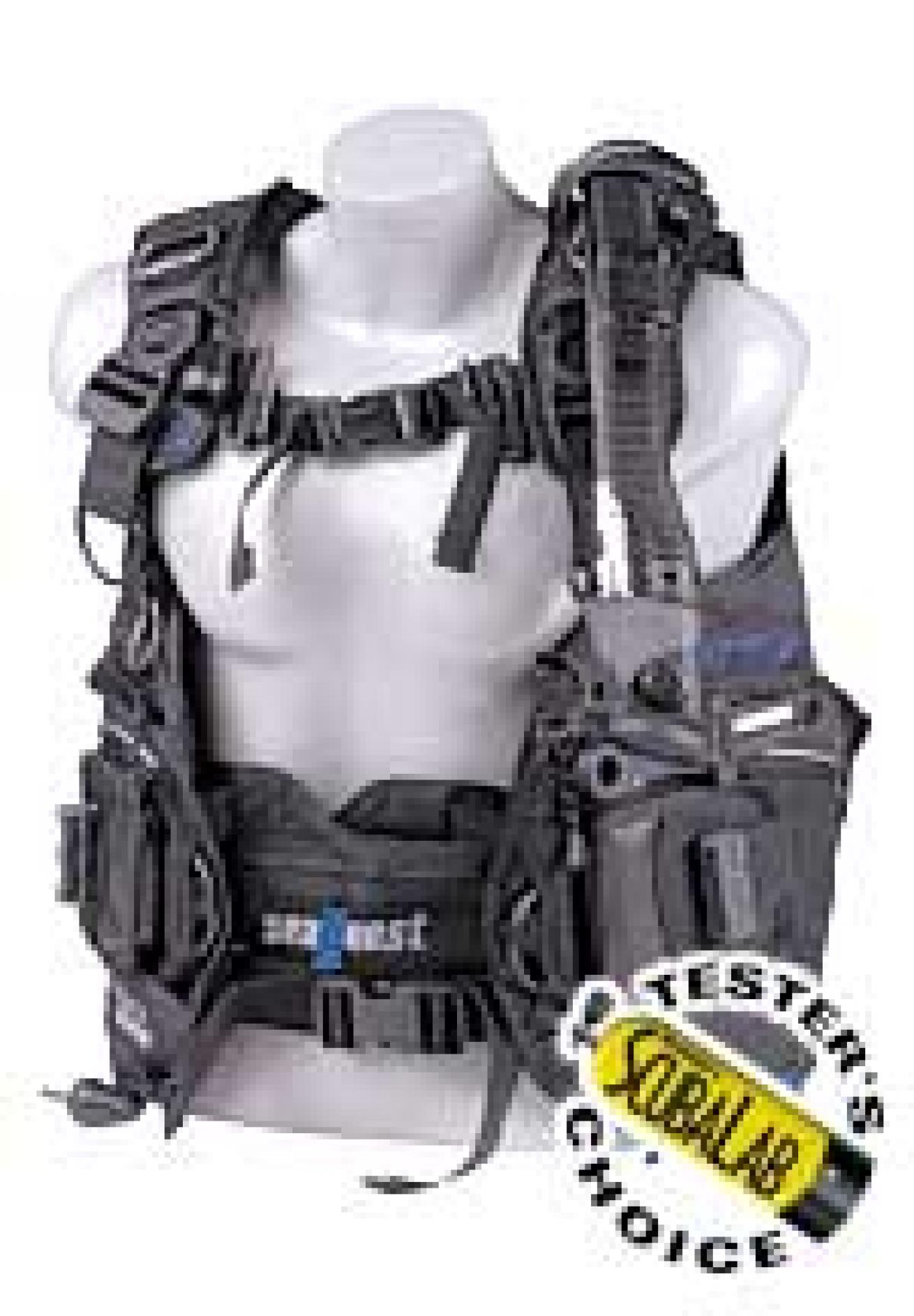
SeaQuest Pro Unlimited|
Price: $820.
Pockets with closures: 3 zippered.
Sizes: 5.
Buoyant lift (claimed): 30-63 lbs.
Weight system: Ditchable, 20-32 lbs.; nonditchable, 10 lbs. max.
Backpack: Hard.
Tank bands: 1.
Thumbs Up: Excellent fit, comfort and adjustment. Perfect scores on weight system. Good stability. Efficient dump valves. Excellent warranty. Excellent owner's manual.
Thumbs Down: Pocket volume eaten up by weights.
SeaQuest Pro Unlimited: First Among Equals
SeaQuest's flagship Pro Unlimited sports the highest price of all BCs in this group and garnered the best test scores, making it a Testers' Choice and first among equals.
The Pro Unlimited shares the same internal gusset, contoured shoulders, padding, multiset waistband and swivel buckle adjustment system as the Pro QD, but throws in a self-adjusting lumbar support system and a vertically adjustable chest strap to allow for dry suit valves. Volume on the two large zippered pockets gets eaten up when weight pouches are loaded, but the cummerbund pocket is larger and easier to access than most.
Like the Pro QD, the Pro Unlimited utilizes a single-flap Velcro weight system. It loads and ditches efficiently. Weight pouches are contoured to match body shape. Two trim weight pouches are tucked in behind the back pad and secured by buckle clips.
Designed for serious diving, the Pro Unlimited comes with six heavy-duty prebent stainless-steel D-rings. Also included is a dive knife in a sheath over the left pocket and a swivel clip on a retractor. The knife is easy to grab, but it can be a challenge slipping it back into the sheath (if you worry about doing damage to your BC or fingers, the knife can be mounted on the console hose instead).
The pull dump on the ambient hose is a little stiff, but the two remote valves provide efficient deflation. Claimed buoyant lift range falls within reasonable variance.
Sherwood Avid
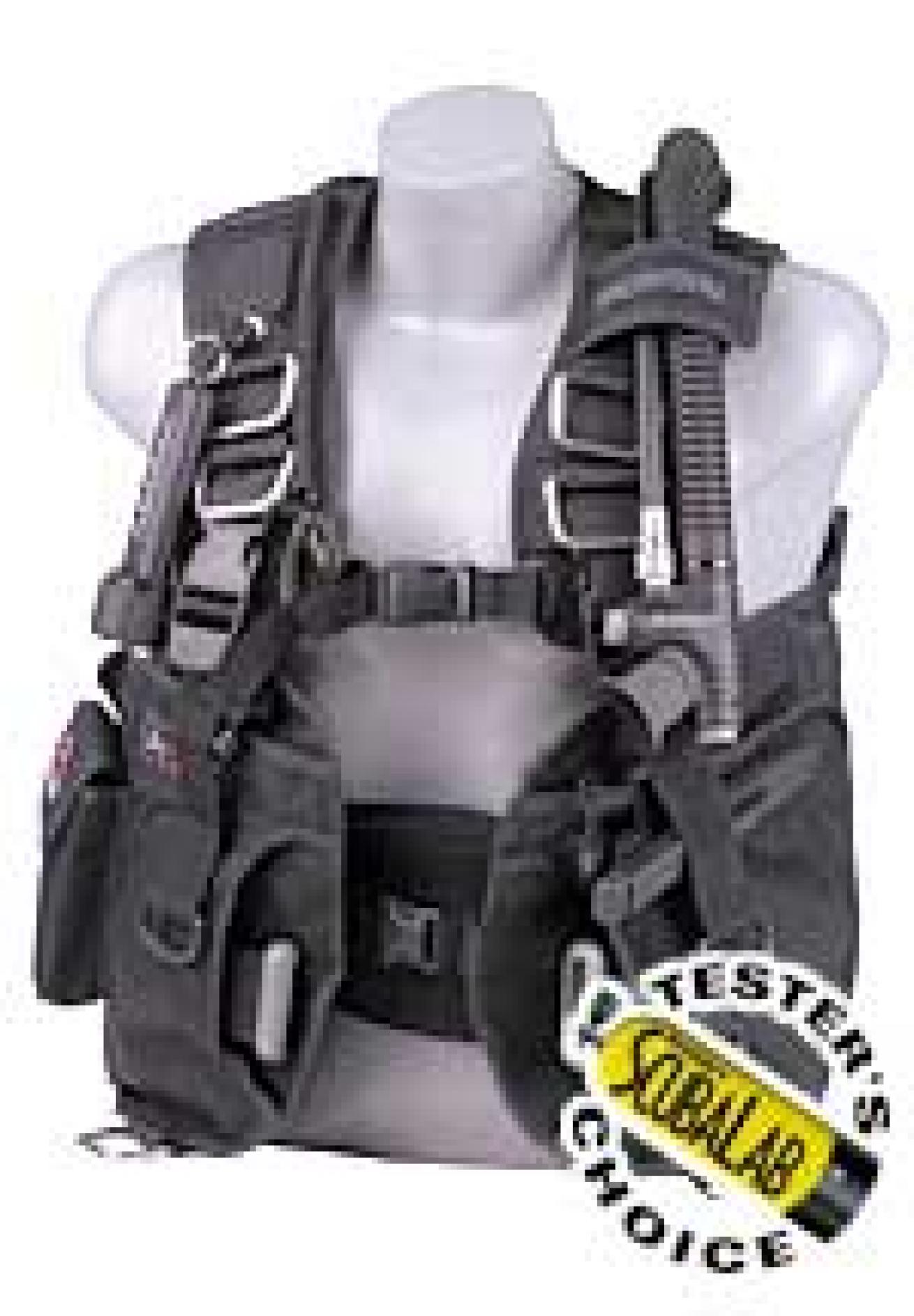
Sherwood Avid|
Price: $475.
Pockets with closures: 2 zippered.
Sizes: 6.
Buoyant lift (claimed): 20-40 lbs.
Weight system: Ditchable, 16-26 lbs.; nonditchable, 10 lbs. max.
Backpack: Soft.
Tank bands: 2.
Thumbs Up: Efficient valve operation. Well-designed power inflator for ascent control. Good scores on assembly, fit, comfort and adjustment. Good to excellent weight system. Excellent owner's manual.
Thumbs Down: Pockets hard to access at depth.
Sherwood Avid: A New Weight System and More
A Testers' Choice, the Sherwood Avid came to these tests with a new mechanical weight ditch system that is standard equipment and a bevy of nifty gadgets that are not.
A newly developed weight pouch security system incorporates two-inch quick-release buckles that connect to the BC. By pulling the plastic weight pouch handles, the male portions of the buckle assemblies contract, disconnect from the BC and release the weight pouches in a smooth one-step motion. Loading the weight pouches while wearing the BC is a stretch--literally: you have to reach back to clip the buckle. But the majority of test divers were able to do it without help from dive buddies.
Various adjustment straps and padding on shoulders, back and lumbar region make the Avid a very comfortable BC. Zippered pockets are large, but difficult to access at depth. There's an additional Velcro pocket designed to hold a foldable snorkel (not included) and six stainless-steel D-rings for attaching gear.
The power inflator fits well in the hand and allows for minute adjustments to fine-tune buoyancy. When it's time to deflate fast, two remote valves along with the pull dump produce efficient flow. Two tank straps provide stability at depth with no apparent tank wobble. Only minimal body squeeze was noted.
The test Avid was equipped with the optional Akona Pro Kit, which includes a dive light on a retractor, a swivel clip on a retractor and a dive knife that mounts to the left pocket.

